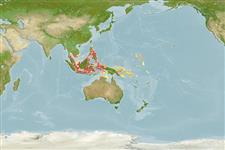Classificação / Names
Nomes comuns | Sinónimos | Catalog of Fishes(Género, Espécies) | ITIS | CoL | WoRMS | Cloffa
>
Ovalentaria/misc (Various families in series Ovalentaria) >
Pomacentridae (Damselfishes) > Pomacentrinae
Etymology: Pomacentrus: Greek, poma, -atos = cover, operculum + Greek, kentron = sting (Ref. 45335); cheraphilus: Named for its predilection for silty habitats; name from Greek meaning silt lover.
Environment: milieu / climate zone / depth range / distribution range
Ecologia
marinhas associadas(os) a recifes; intervalo de profundidade 10 - 18 m (Ref. 86257). Tropical
Western Pacific: Brunei and the Philippines.
Tamanho / Peso / Idade
Maturity: Lm ? range ? - ? cm
Max length : 6.1 cm SL macho/indeterminado; (Ref. 86257)
Descrição breve
Chaves de identificação | Morfologia | Morfometria
Espinhos dorsais (total) : 13; Raios dorsais moles (total) : 13 - 14; Raios anais moles: 13 - 15. This species is distinguished by this set of characters: D XIII, 13-14; A 13-15; pectoral rays 17-18; tubed lateral-line scales 17-19; total gill rakers on the first branchial arch 19-21; yellow juvenile phase with blue stripes on the upper head and adjacent anterodorsal portion of the body; light grey to dark greyish brown adult phase with a dark-edged greenish spot just below lateral line origin (Ref. 86257).
Adults inhabit silty reefs around coral and rock outcrops (Ref. 86257). Oviparous, distinct pairing during breeding (Ref. 205). Eggs are demersal and adhere to the substrate (Ref. 205). Males guard and aerate the eggs (Ref. 205).
Life cycle and mating behavior
Maturidade | Reprodução | Desova | Ovos | Fecundidade | Larvas
Oviparous, distinct pairing during breeding (Ref. 205). Eggs are demersal and adhere to the substrate (Ref. 205). Males guard and aerate the eggs (Ref. 205).
Allen, G.R., M.V. Erdmann and V.V. Hilomen, 2011. A new species of damselfish (Pomacentrus:Pomacentridae) from Brunei and the Philippines. aqua, Int. J. Ichthyol. 17(1):35-42. (Ref. 86257)
Categoria na Lista Vermelha da IUCN (Ref. 130435: Version 2024-1)
Ameaça para o homem
Harmless
Utilização humana
Ferramentas
Relatórios especiais
Descarregue XML
Fontes da internet
Estimates based on models
Preferred temperature (Ref.
123201): 28.5 - 29.2, mean 28.9 °C (based on 662 cells).
Phylogenetic diversity index (Ref.
82804): PD
50 = 0.5000 [Uniqueness, from 0.5 = low to 2.0 = high].
Bayesian length-weight: a=0.02455 (0.01155 - 0.05216), b=2.98 (2.81 - 3.15), in cm total length, based on LWR estimates for this Genus-body shape (Ref.
93245).
Nível Trófico (Ref.
69278): 2.7 ±0.3 se; based on size and trophs of closest relatives
Resiliência (Ref.
120179): Elevada, tempo mínimo de duplicação da população menor que 15 meses (Preliminary K or Fecundity.).
Fishing Vulnerability (Ref.
59153): Low vulnerability (10 of 100).
